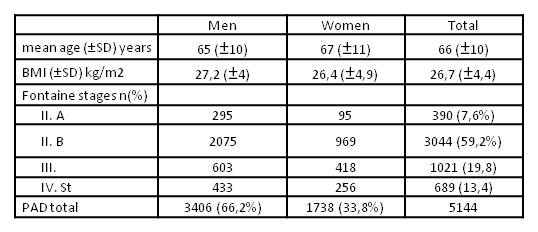RISK PROFILE AND CO-EXISTING VASCULAR DISEASE IN PATIENTS WITH SYMPTOMATIC PERIPHERAL ARTERIAL DISEASE IN CLINICAL PRACTICE
Background: peripheral artery disease is a serious disease with high morbidity and mortality. Identification of the main determinants of disease progression has great impact for the care of these patients, especially in clinical practice. We sought to assess the main characteristics of the population of symptomatic PAD treated in our department and their risk profile.
Methods: We performed an analysis of our peripheral angiography database from 1.1.2000 to 31.12.2009. A total of 12673 records were reviewed.
Results: a final population of 5144 patients with symptomatic PAD was included (3406 men, age 66 ± 10 years). The main characteristics of the study population are recapitulated in Table 1. We did not find significant difference in the prevalence of PAD between men and women across all stages. The most frequent risk factors were arterial hypertension (74%) and smoking (65,4%). Diabetes mellitus was present in 38,3% and hyperlipoproteinaemia in 56,9% of patients. However, the prevalence of some risk factors was different for both genders. Arterial hypertension was less frequent in women in comparison to men (26,3% vs 64,9%, p <0.0001. Also, men had more frequent history of smoking (73,7% vs 26,3%, p <0.0001). Coronary artery disease (CAD) was present in 42,6% of cases and cerebral artery disease in 11.7%. Women in this study had significantly lower incidence of CAD (41,7% vs 58,3%, p <0.0001).
Conclusion: the prevalence of classic risk factors of atherosclerosis in patients with symptomatic PAD is very high. However, some minor differences can be found between both genders. Maximal effort should be made to achieve better control of risk factor and appropriate treatment should be implemented to improve outcome of this very high risk population.


